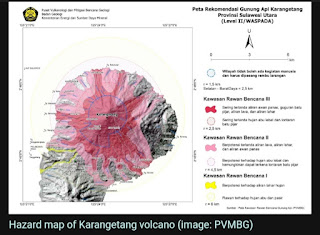Karangetang News
The Pusat Vulkanologi dan Mitigasi Bencana Geologi (PVMBG) announced that the effusive eruption at the volcano has stopped or at least has decreased its activity.
Since 1 April, visual observations confirm neither lava flows nor glowing lava blocks from the lava dome within the southerly located Crater 1.
However, a visible near-constant glow is being monitored from Crater 2, oriented north.
Passive emissions of steam and gas continue to emit from craters rising approx. 200 meters above the volcano.
The seismic activity has waned simultaneously with the diminished effusive activity. During 1-25 April, the monitoring station recorded about 130 hybrid earthquakes, 76 shallow earthquakes, 19 deep earthquakes and 15 volcano-tectonic tremor events.
Hence, a decision has been made to lower the alert level for the volcano to Level 2.
In order to risk mitigation, people are not allowed to approach the Main crater area (south) within a 1.5 km radius and the North crater area within a 2.5 km radius. Due to the accumulation of relatively fresh lava material, resulting from lava flows and dome blocks, the current hazards for people may pose hot avalanches that are prone to collapse and can become mobilized into pyroclastic flows of various sizes.
In early February, the volcano entered into the intense phase by generating incandescent avalanches from the fresh magma-filling lava dome within Crater 1 onto the western and eastern slopes. The situation intensified by dangerous pyroclastic flows on the southeastern side in late February.
Source: Pusat Vulkanologi dan Mitigasi Bencana Geologi volcano activity update 27 April 2023



Yorumlar
Yorum Gönder